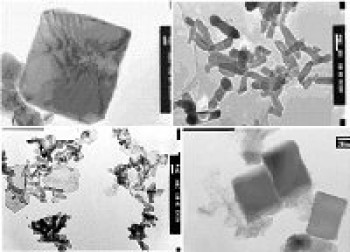News
Continuous Hydrothermal Syntheses of Nanomaterials: From Lab to Pilot Plant
26 March 2007

TEM images of nanoparticles (<100nm) made using hydrothermal flow technology. a) CuO plates, b) hydroxyapatite rods, c) a co-precipitate of Ni hydroxide (plates) and La hydroxides (needles) and d) Co3O4 blocks.
Dr Jawwad A. Darr (UCL Chemistry Department) and colleagues at QMUL (I. Rehman and S. Yang of the Materials Dept) and academics at Leeds University, respectively, have been awarded yet another large EPSRC consortium grant worth ca. 1 million pounds [ref EP/E040551 and EP/E040624/1].
The project seeks to develop the know how to go from a novel laboratory system for making nanoparticles towards a mini pilot plant and as a result, develop a generic strategy for scaling-up and controlled manufacture of products with consistent, re-producible and predictable quality. As part of the project, a mini pilot plant will be established at UCL in 2008 and will be used to generate significant qualities of nanoparticles for industrial collaborators to evaluate for prototyping and proof of concept demonstration in products incorporating nanoceramics. The academic and industrial team will be assisted by the KTN for resource efficiency, who are helping to find additional consortium partners that could benefit from access to the proposed pilot plant.
This new award to the team, follows hot on the heels of a previous EPSRC consortium project on “high throughput nanoceramics discovery” (2006-2009) in which the aforementioned nanoparticle synthesis technology is being used to generate libraries of nanomaterials in order to develop better photocatalysts for photocatalytically splitting water to make hydrogen fuel (and oxygen) [EPSRC ref EP/D038391/1 and .EP/D038499/1].
The project seeks to develop the know how to go from a novel laboratory system for making nanoparticles towards a mini pilot plant and as a result, develop a generic strategy for scaling-up and controlled manufacture of products with consistent, re-producible and predictable quality. As part of the project, a mini pilot plant will be established at UCL in 2008 and will be used to generate significant qualities of nanoparticles for industrial collaborators to evaluate for prototyping and proof of concept demonstration in products incorporating nanoceramics. The academic and industrial team will be assisted by the KTN for resource efficiency, who are helping to find additional consortium partners that could benefit from access to the proposed pilot plant.
This new award to the team, follows hot on the heels of a previous EPSRC consortium project on “high throughput nanoceramics discovery” (2006-2009) in which the aforementioned nanoparticle synthesis technology is being used to generate libraries of nanomaterials in order to develop better photocatalysts for photocatalytically splitting water to make hydrogen fuel (and oxygen) [EPSRC ref EP/D038391/1 and .EP/D038499/1].
Updated by: Victoria Wells




